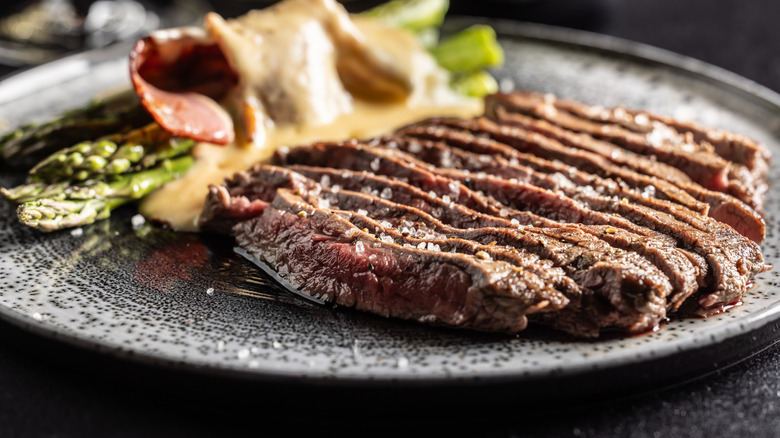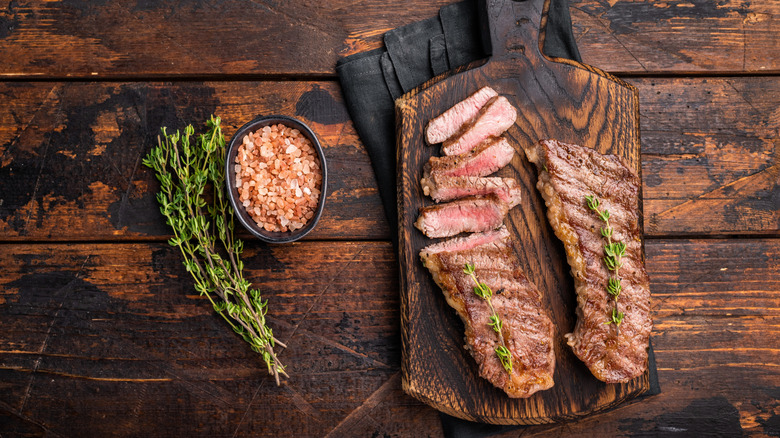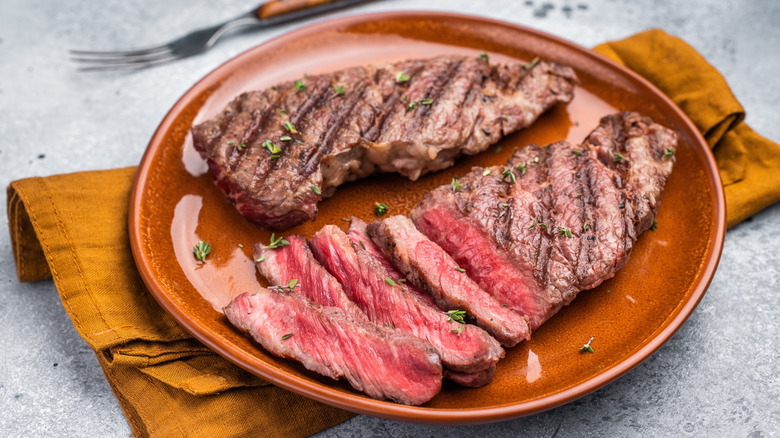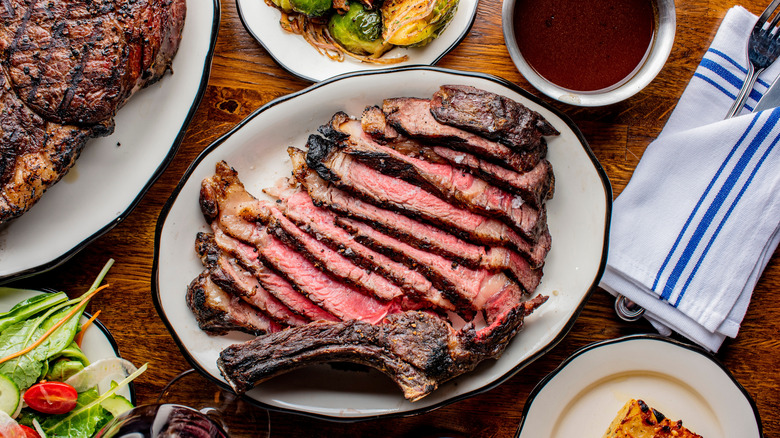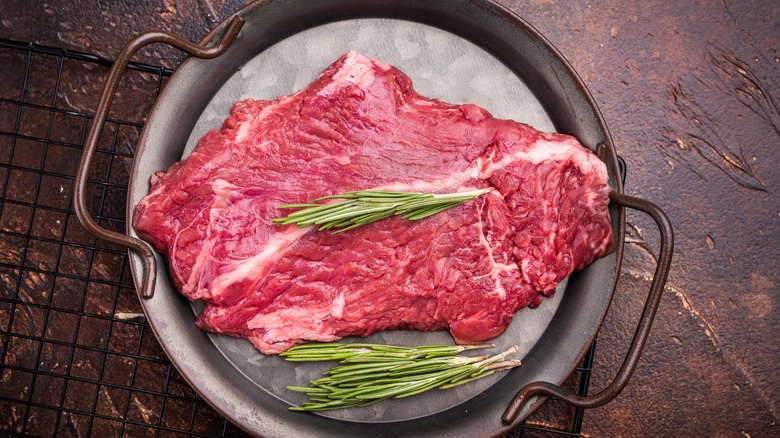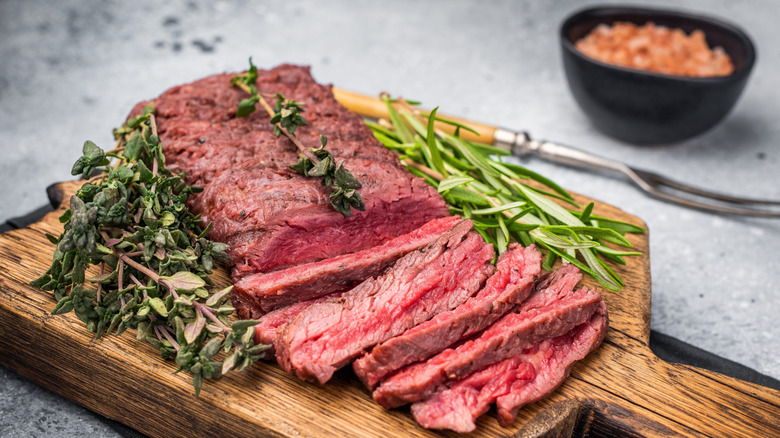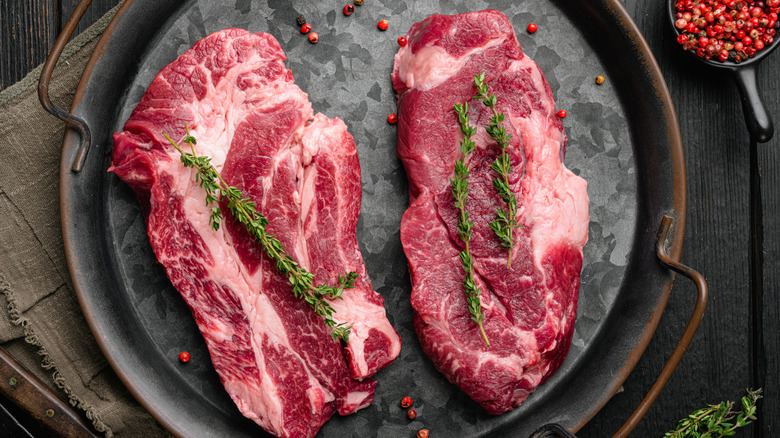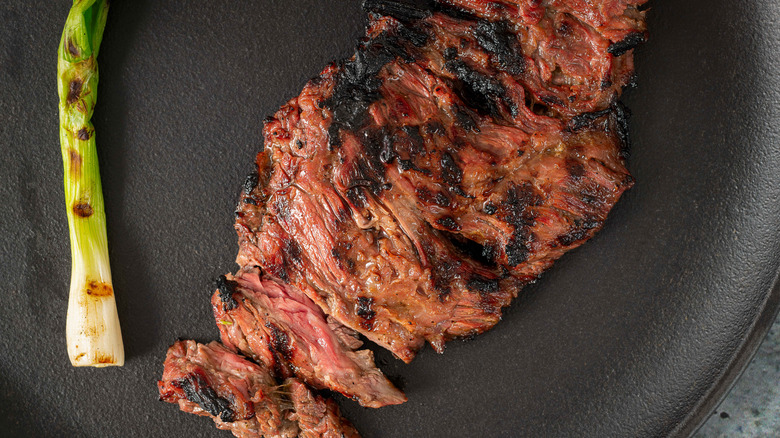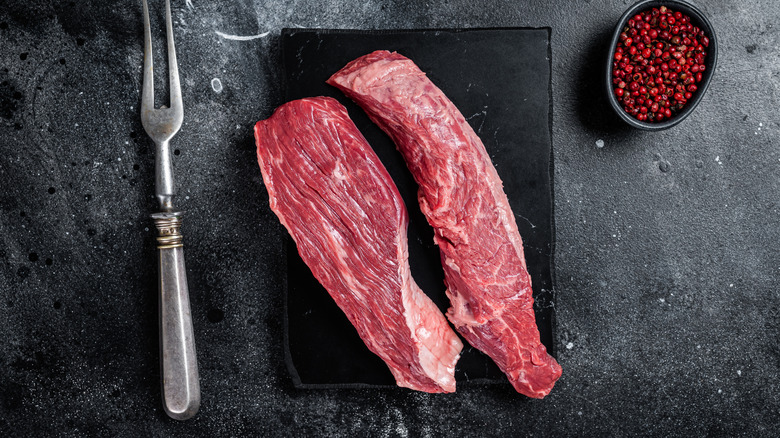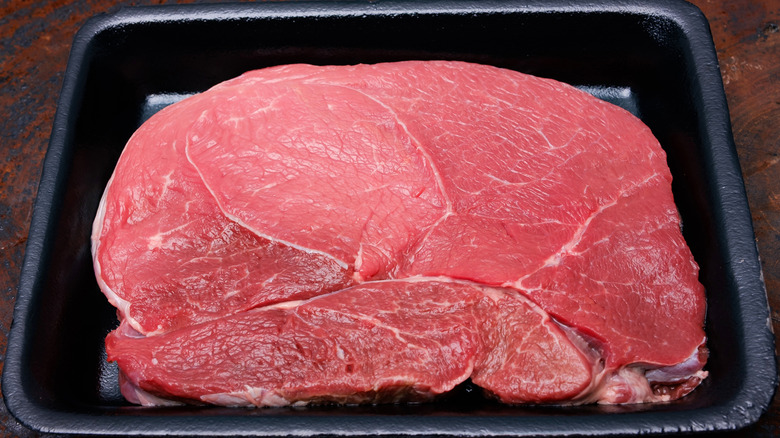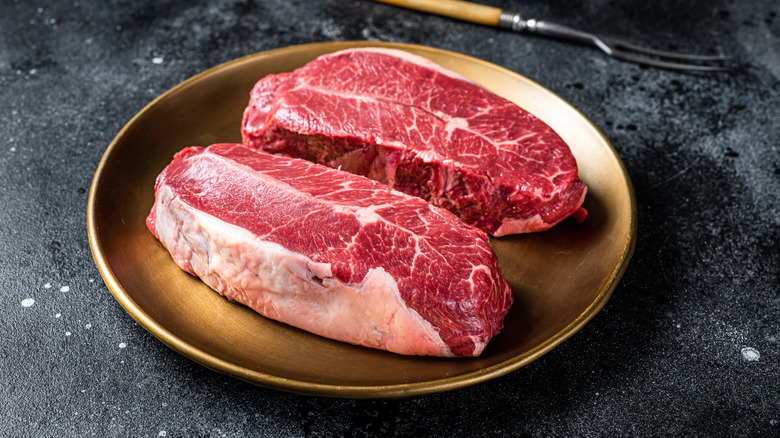10 Lesser-Known Cuts Of Steak That Won't Break The Bank
Not all of us have loads of money to spend on steak. Although some of the best steak cuts out there are worth the money, they can also be wildly expensive for everyday cooking. Even at an affordable retailer like Walmart, ribeye steak can come in at almost $22.50 per pound of meat, and if you're cooking for a full family, then the cost can really add up. Call us greedy, though, but we don't want to compromise on the steak part of our diet, even at a time when the cost of living is high. So, how do we carry on eating it without blowing our entire budget?
The answer is by figuring out which steak cuts out there are more affordable, but still just as tasty. Steaks tend to get more expensive based on fat content and the amount of marbling across the meat. Cheaper cuts are usually leaner, which can make them a touch less juicy. However, there are cuts like blade steak and top sirloin, which can give you a good amount of fat while remaining well within a reasonable price range. Elsewhere, there are cuts that require a little more effort to ensure they don't become too chewy, but which can still be transformed into delicious pieces of meat suitable for numerous uses. Let's check out a few of our favorites.
Tri-tip steak
Tri-tip feels like a well-kept secret in the steak world. This cut comes from the bottom of the sirloin, and it has all of the meatiness and richness of the other meat in that area. However, it's often overlooked because of its slightly irregular shape. As its name indicates, tri-tip has a roughly three-sided, slightly thick shape that tapers into a tip at the end. It's this shape that makes it a little harder to know what to do with it, as you can't exactly sear it in a skillet like you would a strip steak.
However, if you're looking for a beef brisket replacement that doesn't cost the earth, then tri-tip's the one for you. Although it can be lean, tri-tip breaks down beautifully when smoked, leaving you with thick, juicy pieces of meat that you can pile into a sandwich. It does all this without breaking the bank, either: You can get tri-tip from small producers for around $11.00 per pound, almost half the price of more expensive cuts like the aforementioned strip steak. Trust us on this one: It's a delicious choice.
Flat iron steak
If the very cool name of flat iron steak (well, in our opinion, anyway) didn't convince you to buy it, then maybe its price will. Also known as oyster blade steak, flat iron comes from the shoulder area, and you can pick up a pound of it for just under $13 at Walmart, making it one of the more affordable cuts from the retailer. For that price, you get a piece of meat that's surprisingly well-marbled, one of the key indicators of flavor in beef. This marbling also gives it a tenderness that stops flat iron steak from getting too tough and chewy, an issue that plagues a lot of cuts from the shoulder area.
Because of this, flat iron steak is delightfully versatile for its price. Its dimensions tend to prevent you from being able to sear it like regular steak and serve it in one big block of meat, but other than that, you can do pretty much anything you want with it. It's a good cut of beef for a sandwich, and it's great stirred into pasta. Plus, because of its tenderness, you don't have to do a great deal to it to make it palatable, nor do you have to cook it for loads of time to break it down.
Merlot steak
Want a steak that's both reasonably priced relative to other cuts of meat and fashionably niche at the same time? If so, you'll want to try Merlot steak. Merlot steak gained its name for its complement to red wine and its deep color, which gives it a similar appearance to filet mignon. Like filet mignon, it's also pretty lean — but it still has a lovely tenderness to it due to its fine grain. This fineness means that it can be cooked as a regular steak would, making it one of those cuts of meat that you don't necessarily have to do a whole lot to. You do, however, need to make sure that you're searing it properly and allowing it to rest, to ensure that it remains juicy.
Merlot steak comes from a smaller muscle in the round primal, which is frequently ground up, and so it can be a little harder to find. When you do, its price can reflect its relative rarity, but it'll still be a lot cheaper than many other cuts — and may have a comparable price to similar affordable ones. At Bootheel 7 Ranch, for instance, you can buy a merlot steak for $10 for an 8 to 12-ounce piece of meat, which is roughly the same price you'd pay for flank steak from the same retailer and way less than other cuts.
Hanger steak
If you're lucky to find hanger steak in a supermarket, you should snap it up as soon as possible. This flavorful cut, which comes from the diaphragm section, is known as the butcher's best-kept secret. Because the actual cut of meat comprises a fairly small portion of the cow, there's only one hanger steak per animal — but its lesser-known status means that it hasn't quite reached the level of exclusivity that something like rib eye or filet mignon has. To be honest, we're super surprised by this: Hanger steak has lovely marbling that gives it a rich taste and succulent tenderness, and it also has a lovely versatility to it.
The only problem with hanger steak is that it can be tricky to track down, meaning that even when it's more affordable than other cuts, it can be on the slightly more expensive end. However, it's important to note that price is relative to quality and to how much other meat cuts cost from the same retailer. At The Fresh Market, for example, its Premium Choice Hanger Steak is $17.99 per pound. That sounds pricey until you consider that bone-in rib eye steak from the same retailer is over $22 per pound, and New York strip steak is a whopping $33.59 for the same weight.
Flank steak
Although flank steak is sometimes confused with skirt steak, it's important to remember that they're two different (albeit similar) cuts of meat. Flank steak comes from the lower abdomen of the cow, and it has a leanness to it that can make it a little chewy for some people. However, that leanness also means that it's got a reasonable price point, and you'll spend way less on it than comparable cuts. At Target, for example, you can grab a pound of USDA Choice flank for $12.99. Opt for ribeye, and you'll spend $17.99 per pound.
Unlike some other cheaper cuts, it's entirely possible to grill flank steak as you would any other kind and for it to turn out relatively tender. The key is to cook it quickly and avoid overcooking: If you cook it any longer than medium (or even medium-rare), it'll toughen up significantly. However, flank steak can also be excellent grilled after soaking in a marinade for a couple of hours to allow the proteins in it to loosen up slightly. Try whipping up a citrusy soak for the beef, with the acidity both helping to soften the meat and work against its rich flavors.
Chuck steak
If you're willing to put in a little bit of time and effort in a bid to save money, chuck steak is gonna be the cut for you. Chuck steak comes from the chuck primal part of the cow, located in the shoulder area. Because the muscles in this area are in constant use, the cuts from it tend to be more lean and therefore tougher. Although there are some cuts from the chuck primal that do have a good amount of fat and marbling, chuck steak isn't one of them — but that doesn't mean you should write it off. It does still have some fat that contributes to its flavor, and it also has an inherently beefy taste that works well for a number of uses.
If none of that convinces you to buy it, though, then perhaps its price will. At Walmart, a pound of chuck steak comes in at just under $10, less than half the amount you'd pay for a pound of ribeye from the retailer. Bear in mind that you'll likely have to marinate or braise chuck steak for it to be at its best. It needs help breaking down, and sizzling it like a ribeye or a porterhouse won't yield the result you crave. For stews, soups, and steak fajitas, though, it's pretty awesome.
Skirt steak
If you're not too worried about the shape of your steak, then skirt steak might be the one for you. This steak is easily identifiable by its long, slim dimensions, and when raw, it has a deep red, almost purple appearance. Don't let that put you off, though: The color indicates its rich, beef-forward flavor, and its shape gives it a surprising amount of versatility. Skirt steak comes from the plate portion of the cow, an area that tends to have fairly lean cuts. Skirt is no different, and while some pieces can have a good amount of marbling, generally speaking, it's fairly lean.
However, it's important to consider the price here. If you're looking for a steak that you can pile into fajitas or stuff into a steak sub, then skirt is going to give you an excellent balance of price to flavor. At Target, you can pick up good-quality skirt steak for just under $13 per pound, considerably less than some of its other steak cuts. As long as you season it properly and give it some time to marinade, you'll be just fine.
Bavette
The fact that bavette is loved by chefs tells you all you need to know about this affordable steak cut. Also known as sirloin flap, it comes in a long, flat shape that's perfect both for grilling in one piece or slicing up and cooking in strips. Bavette is a butcher's cut, meaning you're less likely to find it outside of butcher's shops and specialist stores. However, if you do manage to get some, you'll be blessed with a deeply meaty flavor and a surprisingly tender texture, given its price.
Plus, that price is pretty good, folks. Bavette steaks aren't the cheapest in the world, but when buying from a quality retailer, they're way more affordable than other cuts. You can find a pound of AAA bavette for around $26; for AAA rib eye or sirloin from the same stores, you can expect to pay $37 and $39, respectively. Although you can marinate this cut to give it more flavor, it can also be cooked as is. Just make sure you slice it against the grain for maximum tenderness.
Sirloin tip
The sirloin tip is a steak cut that we think is pretty deceptive. Its name implies that it comes from the sirloin section of the cow, but it actually comes from the round primal, located at the upper portion of the rear legs. This area is in constant use by the animal as it walks around, and so the meat in the area is generally well-worked and fairly lean. The sirloin tip, which comes from the front portion of the round primal, has these qualities and is generally fairly low in fat.
However, that doesn't mean that you should write it off. Sirloin tip is one of the most cost-effective ways to consume steak: You can pick up a pack of it at $10.49 per pound at Publix, approximately $5 less than what you'd pay for porterhouse from the retailer. Granted, the latter will be fattier and more tender, but sirloin tip can still give you a great result without having to spend the earth. You can slice it up into rounds and cook it just as you would a regular steak (although we would heavily recommend marinating it first to soften it), but a far better option is to cook it low and slow in the oven. When roasted for 4 to 6 hours at a low temperature, it'll fall apart at the merest touch and burst with rare flavor, served with gravy.
Blade steak
Located in the chuck (or shoulder) area of the cow is a little-known steak that might be the best-tasting piece of meat you have had in years. The blade steak, also known as chicken steak, is sliced from the larger top blade and is known for having a large seam of connective tissue running through the middle. This can make it slightly impractical to grill, but that's no reason to write it off. When prepared and cooked correctly, both the connective tissue and the meat become tender, resulting in a delightfully rich-tasting steak.
The way to do this is by slow-cooking your blade steak for several hours at a low temperature, or by braising it until soft and juicy. Alternatively, you can slice around the connective tissue in the middle and use the beef pieces for a stir-fry or stew. If you do decide to grill a blade steak, you'll need to trim it carefully and marinate it before cooking. No matter how you cook it, though, you'll be doing so knowing that you didn't spend the earth on it. You can pick up blade steak for around $13.29 per pound at Publix, making it one of the cheaper cuts out there.
